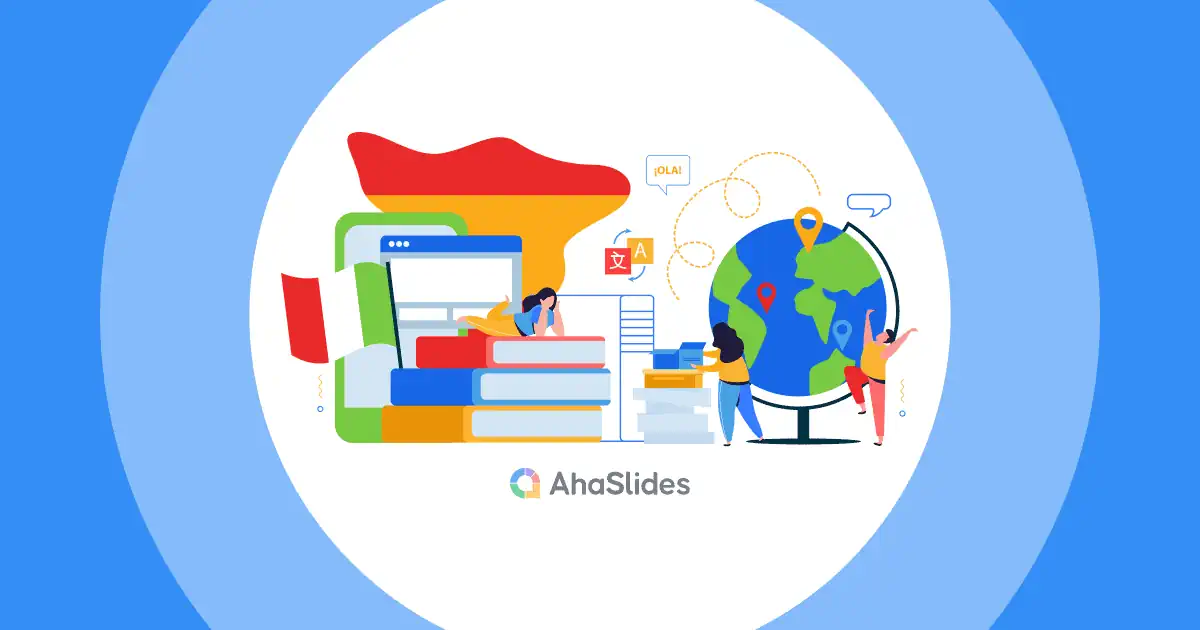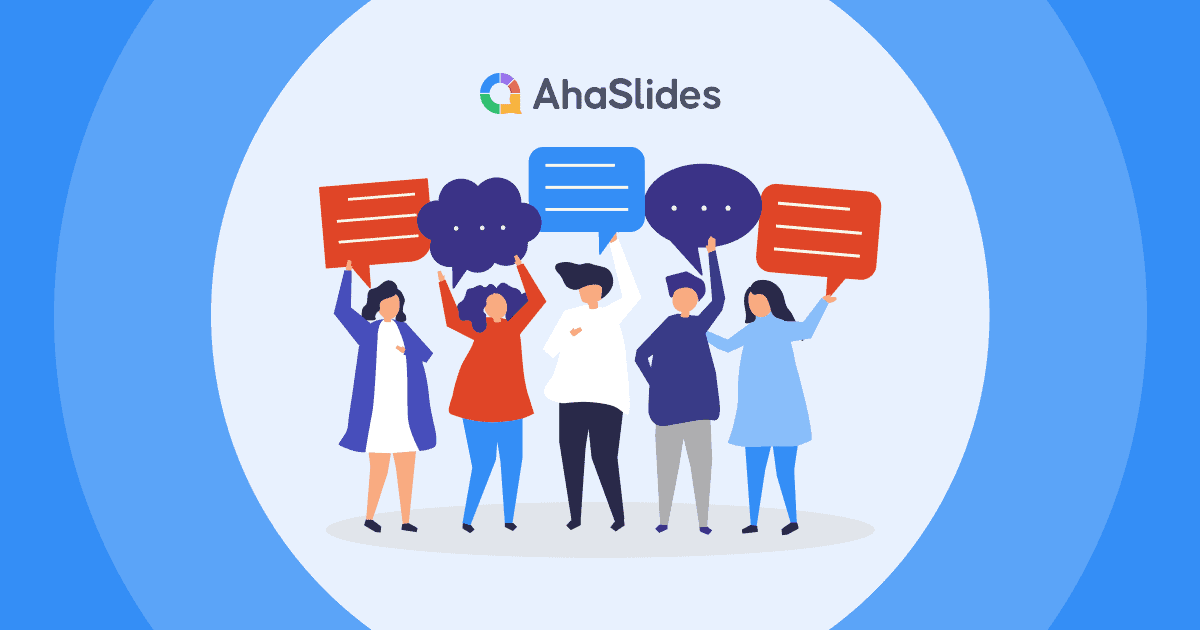Remember when getting students to participate meant endlessly calling on raised hands, hoping someone—anyone—would answer? Or watching rows of glazed eyes as you powered through yet another slide deck?
Those days are behind us.
Classroom response systems have evolved from expensive plastic clickers into powerful, web-based platforms that transform how educators engage learners. These tools turn passive lecture halls into active learning environments where every voice counts, understanding is measured in real-time, and adjustments happen instantly.
Whether you're a teacher looking to energise your classroom, a corporate trainer building more effective sessions, or an educator navigating hybrid learning, this guide explores what modern classroom response systems offer and how to choose the right one for your needs.
What Are Classroom Response Systems?
A classroom response system (CRS)—also called a student response system or audience response system—is an interactive technology that lets instructors pose questions and gather participant responses in real-time.
The concept dates back to the 2000s when participants used physical "clickers" (small remote-control devices) to beam radio-frequency signals to a receiver connected to the instructor's computer. Each clicker costs roughly $20, has only five buttons, and serves no purpose beyond answering multiple-choice questions. The limitations were significant: forgotten devices, technical failures, and substantial costs that made deployment impractical for many schools.
Today's classroom response systems operate entirely through web-based platforms. Participants respond using smartphones, tablets, or laptops they already own—no special hardware required. Modern systems do far more than basic polls: they facilitate live quizzes with instant scoring, gather open-ended responses through word clouds, enable Q&A sessions, create interactive presentations, and provide detailed analytics on participation and understanding.
The transformation has democratised access. What once required significant capital investment now works with free or affordable software and the devices participants already carry.
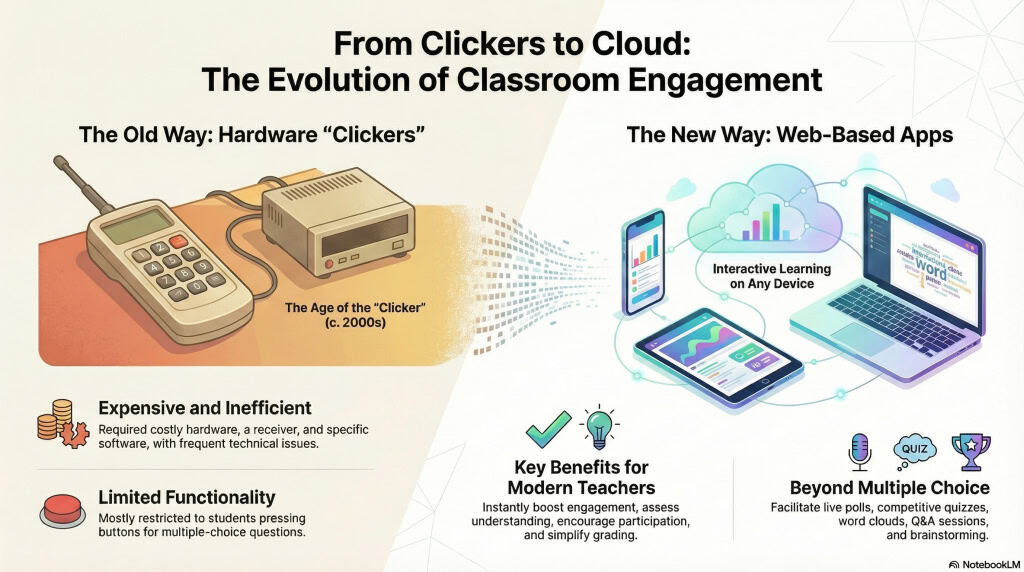
Why Classroom Response Systems Transform Learning
The appeal of classroom response systems extends beyond novelty. Research consistently demonstrates that these tools fundamentally improve learning outcomes through several mechanisms.
Active Learning Over Passive Consumption
Traditional lecture formats place learners in passive roles—they observe, listen, and perhaps take notes. Classroom response systems activate different cognitive processes. When participants must formulate responses, they engage in active retrieval practice, which cognitive science has shown strengthens memory formation and deepens understanding far more effectively than passive review.
Real-Time Formative Assessment
Perhaps the most powerful benefit is immediate feedback—for both instructors and learners. When 70% of your participants miss a quiz question, you know immediately that the concept needs reinforcement. When participants see their anonymous answers compared to the class as a whole, they gauge their understanding relative to peers. This instant feedback loop enables data-driven instruction: you adjust explanations, revisit challenging concepts, or move forward confidently based on demonstrated comprehension rather than assumptions.
Inclusive Participation
Not every learner raises their hand. Some participants process information internally, others feel intimidated by large groups, and many simply prefer to observe. Classroom response systems create space for every participant to contribute anonymously. The shy participant who never speaks up suddenly has a voice. The ESL learner who needs extra processing time can respond at their own pace in self-paced modes. The participant who disagrees with the majority perspective can express that view without social pressure.
This inclusive dynamic transforms group learning. Research on equity in education consistently shows that participation gaps narrow significantly when anonymous response systems replace traditional call-and-response methods.
Data-Driven Insights for Instruction
Modern platforms track participation patterns, question performance, and individual progress over time. These analytics reveal trends that informal observation might miss: which concepts consistently confuse learners, which participants may need additional support, how engagement levels fluctuate throughout sessions. Armed with these insights, instructors make informed decisions about pacing, content emphasis, and intervention strategies.
Application Beyond Traditional Education
While classroom response systems gained prominence in K-12 and higher education, their benefits extend to any context where engagement matters. Corporate trainers use them to assess knowledge retention in professional development sessions. Meeting facilitators deploy them to gather team input and drive decision-making. Event presenters leverage them to maintain audience attention across long presentations. The common thread: transforming one-directional communication into interactive dialogue.
How to Implement Classroom Response Systems Effectively
Purchasing a platform is the easy part. Using it strategically requires thoughtful planning.
Start With Purpose, Not Platform
Before comparing features, clarify your objectives. Are you checking comprehension at key lesson moments? Running high-stakes quizzes? Gathering anonymous feedback? Facilitating discussions? Different platforms excel at different purposes. Understanding your primary use case narrows your options and prevents you from paying for features you won't use.
Design Questions Intentionally
The quality of your questions determines the quality of engagement. Multiple-choice questions work well for checking factual knowledge, but deeper learning requires open-ended prompts, analysis questions, or application scenarios. Mix question types to maintain interest and assess different cognitive levels. Keep questions focused—trying to assess three concepts in one prompt confuses participants and muddies your data.
Strategic Timing Within Sessions
Classroom response systems work best when deployed strategically, not constantly. Use them at natural transition points: warming up participants at the beginning, checking understanding after explaining complex concepts, refreshing energy during mid-session lulls, or wrapping up with exit tickets that reveal what participants learned. Overuse diminishes impact—participants become fatigued when every five minutes requires device interaction.
Follow Up on Data
The responses you collect are only valuable if you act on them. If 40% of participants miss a question, pause and re-explain the concept before moving on. If everyone answers correctly, acknowledge their understanding and increase pace. If participation drops, adjust your approach. The immediate feedback these systems provide is useless without responsive instruction.
Start Small, Expand Gradually
Your first session with a classroom response system may feel clunky. Technical hiccups occur, question design needs refinement, timing feels awkward. This is normal. Start with one or two simple polls per session. As you and your participants become comfortable, expand usage. The instructors who see the greatest benefits are those who persist past initial awkwardness and integrate these tools into their regular practice.
Best 6 Classroom Response Systems in 2025
Dozens of platforms compete in this space. These seven represent the most robust, user-friendly, and proven options across different teaching contexts.
1. AhaSlides
Best for: Professional trainers, educators, and presenters who need an all-in-one presentation and engagement platform
AhaSlides distinguishes itself by combining presentation creation with interaction tools in one platform. Rather than building slides in PowerPoint and then switching to a separate polling tool, you create and deliver interactive presentations entirely within AhaSlides. This streamlined approach saves time and creates more cohesive sessions.
The platform offers extensive question types: live polls, quizzes with leaderboards, word clouds, Q&A sessions, open-ended questions, scales and ratings, and brainstorming tools. Participants join via simple codes from any device without creating accounts—a significant advantage for one-off sessions or participants who resist downloads.
The analytics depth stands out. Rather than basic participation counts, AhaSlides tracks individual progress over time, reveals which questions challenged participants most, and exports data in Excel format for further analysis. For instructors focused on data-driven improvements, this level of detail proves invaluable.
Pros:
- All-in-one solution combining presentation creation and interaction
- Extensive question types beyond basic polls and quizzes
- No account required for participants—join via code
- Works seamlessly for in-person, virtual, and hybrid sessions
- Detailed analytics and data export capabilities
- Integrates with PowerPoint, Google Slides, and Microsoft Teams
- Free plan supports meaningful usage
Cons:
- Free plan limits participant numbers, requiring paid upgrade for larger groups
- Participants need internet access to join
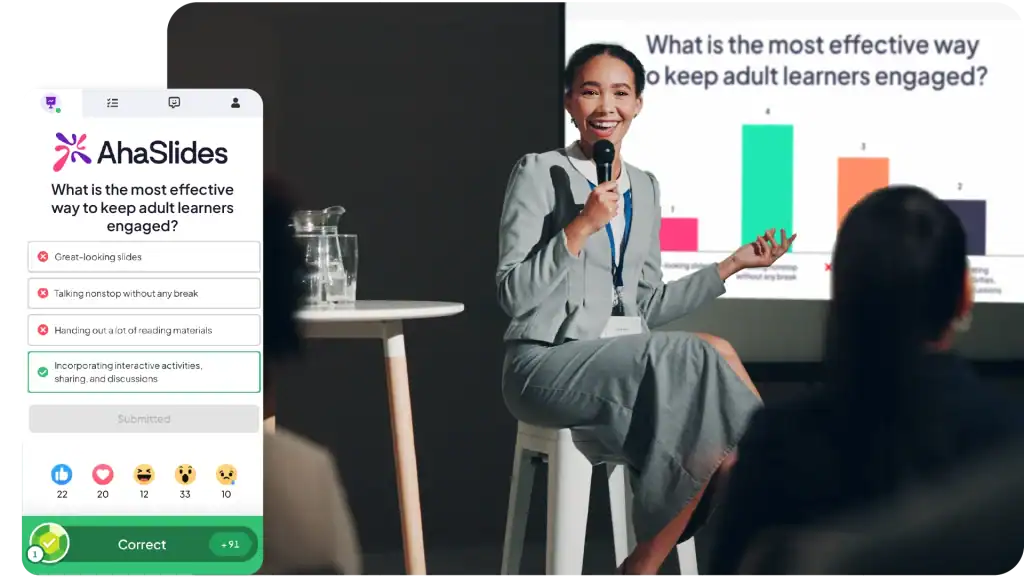
2. iClicker
Best for: Higher education institutions with established LMS infrastructure
iClicker has long been a staple in university lecture halls, and the platform has evolved beyond its hardware roots. While physical clickers remain available, most institutions now use the mobile app or web interface, eliminating hardware costs and logistics.
The platform's strength lies in its deep integration with learning management systems like Canvas, Blackboard, and Moodle. Grades automatically sync to gradebooks, attendance data flows seamlessly, and setup requires minimal technical expertise. For institutions already invested in LMS ecosystems, iClicker slots in naturally.
Analytics provide detailed insights into performance patterns, highlighting both class-wide trends and individual student progress. The research-backed pedagogical guidance iClicker provides helps instructors design more effective questions rather than simply offering a technology tool.
Pros:
- Robust LMS integration with major platforms
- Detailed analytics on student performance
- Flexible delivery through mobile, web, or physical devices
- Established reputation in higher education
- Research-backed pedagogical resources
Cons:
- Requires subscriptions or device purchases for large classes
- Steeper learning curve than simpler platforms
- Better suited to institutional adoption than individual use

3. Poll Everywhere
Best for: Quick, straightforward polls and Q&A sessions
Poll Everywhere focuses on simplicity. The platform does polls, Q&A, word clouds, and surveys exceptionally well without the complexity of full presentation builders or extensive gamification.
The generous free plan—supporting up to 25 participants with unlimited questions—makes it accessible for smaller classes or trainers testing interactive methods. Responses appear directly in your presentation slide, maintaining flow without switching between applications.
The platform's longevity (founded in 2008) and widespread adoption provide reassurance about reliability and ongoing development. Universities, corporate trainers, and event presenters trust Poll Everywhere for consistent performance in high-stakes environments.
Pros:
- Extremely easy to use with minimal learning curve
- Generous free plan for smaller groups
- Multiple question types including clickable images
- Real-time feedback displays directly in presentations
- Strong track record and reliability
Cons:
- Single access code means managing question flow requires hiding previous questions
- Limited customisation compared to more robust platforms
- Less suitable for complex quizzes or gamified learning
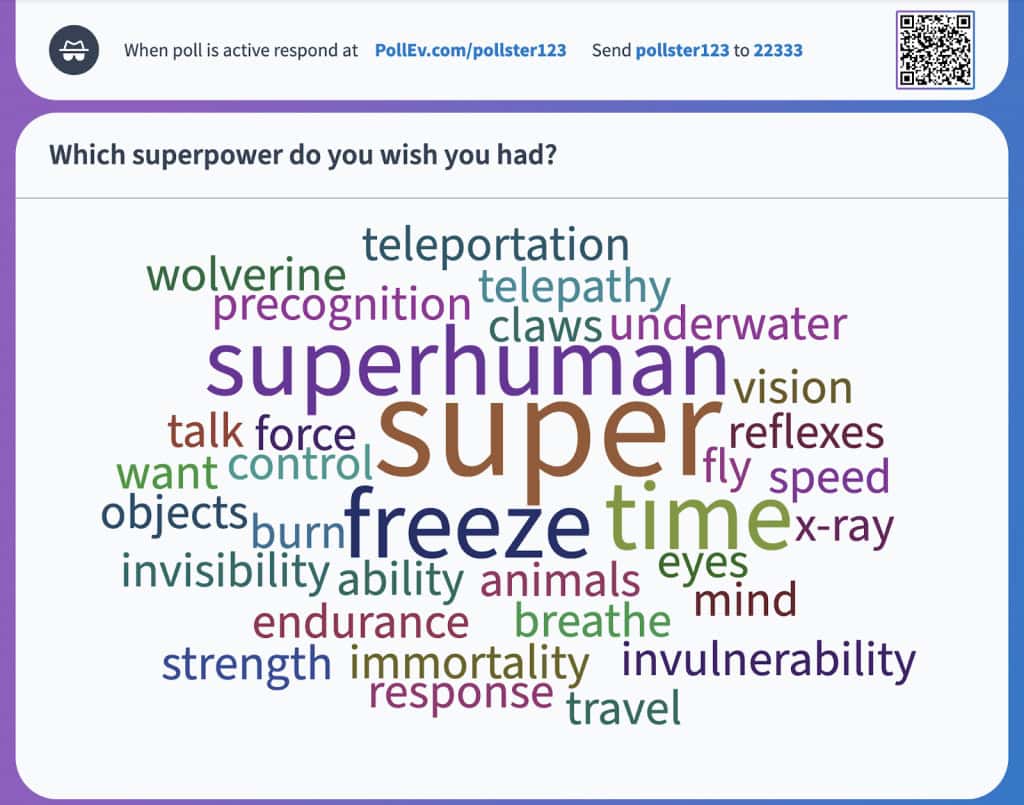
4. Wooclap
Best for: Higher education and professional training with emphasis on collaborative learning
Wooclap stands out for its pedagogical depth and extensive question variety. Developed in collaboration with neuroscientists and learning technologists, the platform offers over 21 different question types designed specifically to enhance information retention and active learning.
What distinguishes Wooclap is its focus on collaborative discussion and critical thinking. Beyond standard polls and quizzes, you'll find sophisticated formats like brainstorming activities, image labelling exercises, gap-fill questions, SWOT analysis frameworks, and script concordance tests. These varied formats prevent monotony and engage different cognitive processes.
Pros:
- Extensive 21+ question types including sophisticated formats for critical thinking
- Developed with neuroscientists for optimal learning outcomes
- Works across all teaching models (in-person, hybrid, remote, asynchronous)
- Strong LMS integration with automatic grade syncing
Cons:
- Interface can feel less playful than gamified platforms like Kahoot or GimKit
- Some features require time to fully explore and master
- Better suited to higher education and professional contexts than K-12
- Not focused on competitive gaming elements
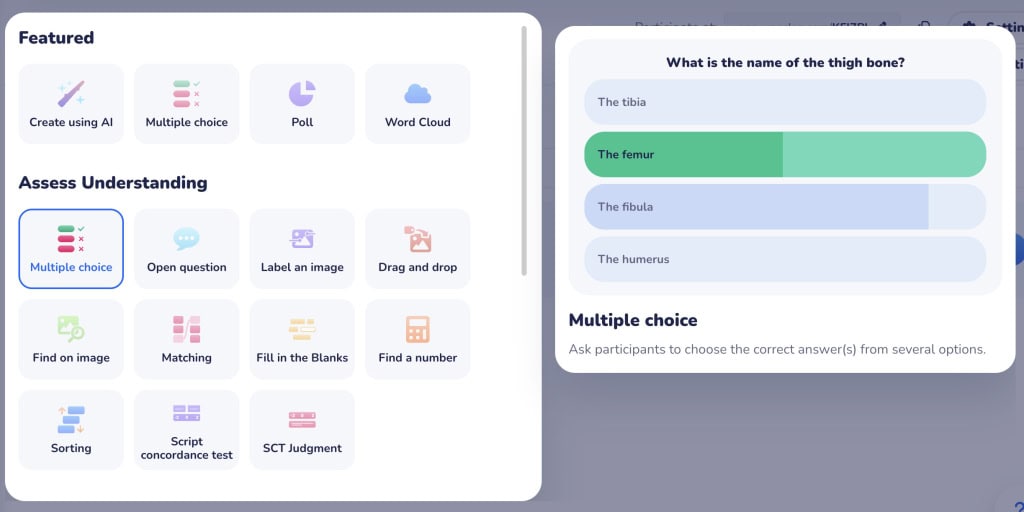
5. Socrative
Best for: Quick formative assessments and quiz creation
Socrative excels at on-the-fly assessment. Teachers appreciate how quickly they can create quizzes, launch them, and receive instant reports showing exactly which concepts participants understood.
The "Space Race" game mode adds competitive energy without requiring the constant leaderboard updates of platforms like Kahoot. Participants race to complete quizzes correctly, with visual progress creating motivation.
The instant reporting reduces grading burden dramatically. Rather than spending hours marking multiple-choice assessments, you receive immediate data showing class performance and can export results for your gradebook.
Pros:
- Extremely fast quiz creation and deployment
- Instant reports showing class performance
- Available on web and mobile apps
- Space Race gamification without excessive complexity
- Simple room management with password protection
Cons:
- Limited question types (no matching or advanced formats)
- No built-in time limits for quiz questions
- Less visually engaging than competitor platforms
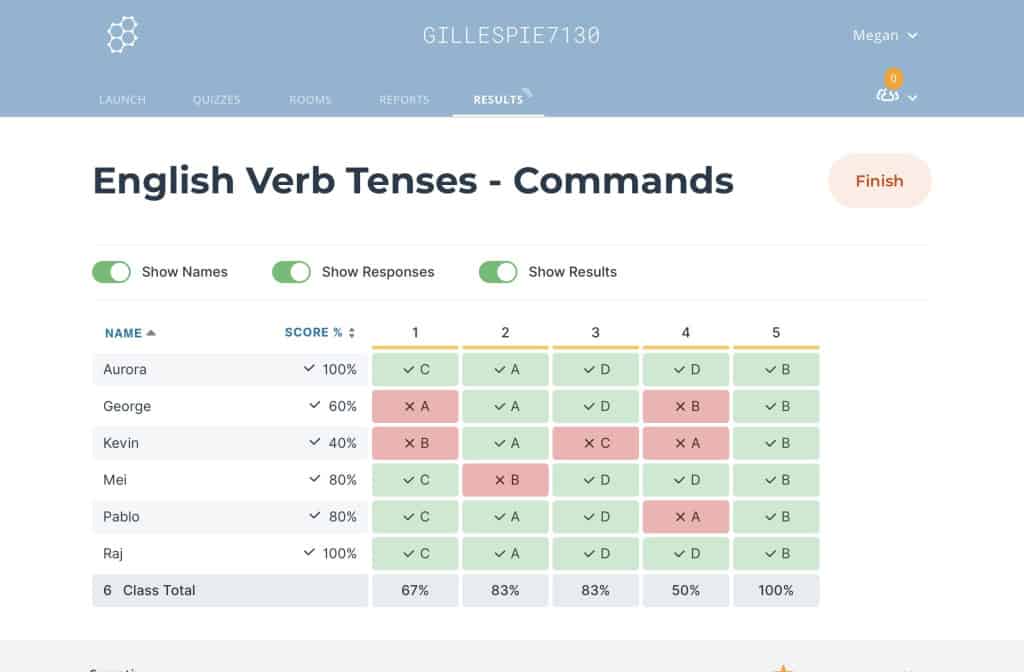
6. GimKit
Best for: Game-based learning for K-12 students
GimKit reimagines quizzes as strategy games. Students answer questions to earn in-game currency, which they spend on power-ups, upgrades, and advantages. This "game within a game" mechanic captures attention more effectively than simple point accumulation.
The ability to import questions from Quizlet or search existing question sets significantly reduces preparation time. Teachers appreciate how the platform continually introduces new game modes, maintaining novelty that keeps students engaged.
The significant limitation is focus—GimKit concentrates almost entirely on quizzes. If you need polls, word clouds, or other question types, you'll need additional tools. The free plan's restriction to five kits also limits exploration.
Pros:
- Innovative game mechanics maintain student interest
- Import questions from Quizlet
- Regular updates with new game modes
- Strong engagement particularly with younger students
Cons:
- Quiz-only focus limits versatility
- Very restricted free plan (five kits only)
- Less suitable for professional training contexts
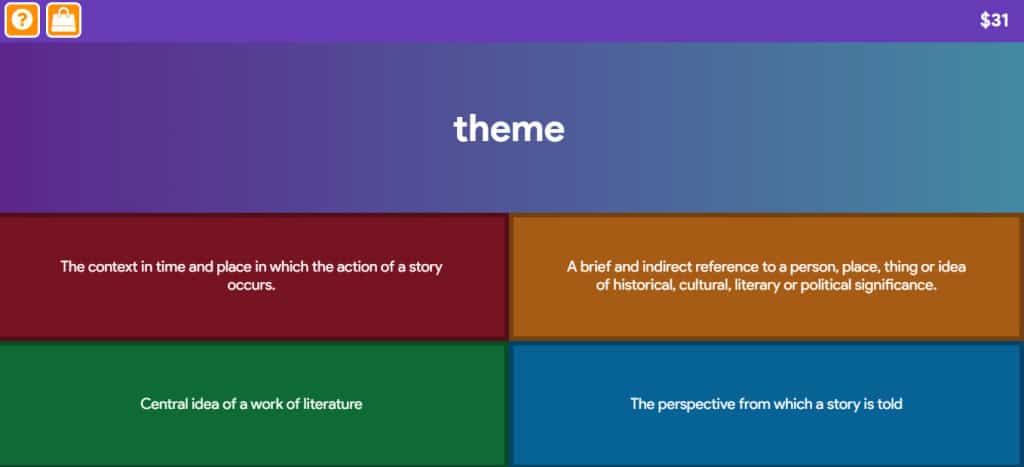
Choosing the Right Platform
Your ideal classroom response system depends on your specific context and goals.
Choose AhaSlides if you want an all-in-one solution combining presentation creation with interaction, need detailed analytics, or work in professional training contexts where polished visuals matter.
Choose iClicker if you're in higher education with established LMS integration needs and institutional support for platform adoption.
Choose Poll Everywhere if you want straightforward polling without complexity, particularly for smaller groups or occasional use.
Choose Acadly if attendance tracking and class communication matter as much as polling and you're teaching larger groups.
Choose Socrative if rapid formative assessment with instant grading is your priority and you want clean, simple functionality.
Choose GimKit if you teach younger students who respond well to game-based learning and you focus primarily on quiz content.
Consider these factors as you decide:
- Primary use case: Polling? Quizzes? Comprehensive engagement?
- Audience size: Different platforms handle different participant volumes
- Context: In-person, virtual, or hybrid sessions?
- Budget: Free plans vs. paid features you actually need
- Existing tools: What integrations matter for your workflow?
- Technical comfort: How much complexity can you and participants handle?
Moving Forward
Classroom response systems represent more than technological novelty—they embody a fundamental shift toward active, participatory, data-informed learning. The most effective educators recognise that engagement and learning outcomes improve measurably when every participant has a voice, when understanding is assessed continuously rather than at course end, and when instruction adapts in real-time based on demonstrated need.
Your first session with any platform will feel awkward. Questions won't land quite right, timing will be off, a participant's device won't connect. This is normal and temporary. The instructors who persist past initial discomfort and integrate these tools into regular practice are the ones who see transformed engagement, improved outcomes, and more satisfying teaching experiences.
Start small. Choose one platform. Deploy one or two questions in your next session. Observe what happens when every participant responds instead of the usual handful of volunteers. Notice how data reveals gaps in understanding you might have missed. Feel the energy shift when passive observers become active participants.
Then expand from there.
Ready to transform your presentations from monologue to dialogue? Explore free interactive templates to start creating engaging sessions today.
Frequently Asked Questions
What is the difference between a classroom response system and a student response system?
The terms are functionally identical and used interchangeably. "Classroom response system" typically appears in K-12 and higher education contexts, while "student response system" is more common in academic research. Some also use "audience response system" when discussing applications beyond education (corporate training, events, etc.). All refer to technology enabling real-time response collection from participants.
Do classroom response systems improve learning outcomes?
Yes, when implemented effectively. Research consistently shows that classroom response systems improve learning outcomes through several mechanisms: they promote active retrieval practice (which strengthens memory formation), provide immediate formative feedback (enabling learners to adjust understanding in real-time), increase participation (particularly among students who rarely speak up), and enable instructors to identify and address misconceptions before they become entrenched. However, simply adopting the technology doesn't guarantee results—question quality, strategic timing, and responsive follow-up determine actual impact on learning.
Can classroom response systems work for remote and hybrid learning?
Absolutely. Modern classroom response systems work seamlessly across in-person, remote, and hybrid environments—often simultaneously. Participants join via web browsers or apps from any location with internet access. For hybrid sessions, some participants can be physically present while others join remotely, with all responses aggregated in the same real-time display. This flexibility proved invaluable during the shift to remote learning and continues to support the increasingly common hybrid model where flexibility matters. Platforms like AhaSlides, Poll Everywhere, and Mentimeter were designed specifically for this cross-environment functionality.




